牛津英语七年级STARTER U9 全英文精品教案
苏教版牛津英语初中七年级上册精品教案全册

苏教版牛津英语初中七年级上册精品教案全册第一部分简要提示(ppt2)一、年级:七年级二、教学内容: 7A Unit 1This is me!三、课型: Checkout四、教学目标1.知识目标:学生掌握本单元教授的语法和语言知识(四会)。
(ppt3)2.能力目标:为学生提供在不同语境中使用新学语法和词汇的机会。
3.情感目标:学生在完成练习的过程中对自己的学习有个客观的评价,以获得成就感,并树立学好英语的自信心。
五、教学重难点1.重点:掌握和运用本单元的词汇,句型和语法。
2.难点:学会在语境中正确运用一般现在时,并注意第三人称单数的用法。
第二部分教学流程Part One Language pointsStep 1.T: Hello, boys and girls! Today let’s learn the last period in Unit 1—Checkout . We will learn to use grammar and vocabulary in our life . 同学们好!今天我们要学习本单元的最后一课—复习检查课。
我们将学会在实际生活中来运用语法和词汇。
(ppt4)First, we’ll learn something about these students. Please do it one by one.首先,我们来了解一些同学的情况.请同学们一个接一个地回答。
(ppt5)T: 1) They are all 12 years old now, so they are of an a_________.2) Simon’s favourite basketball p________ is Yao M ing.3) Amy’s hair isn’t long , it’s s__________.4) We have Chinese, English, M_______ and PE on Monday.5 )Simon often plays football on the football f__________ after school.(ppt6)6) Millie e_______ reading books after class.7) My friend Kitty likes listening to m______.8) We love to f_______ kites in the park in spring.9) Simon always b_________ my ruler when he does his homework.10) Sandy is good at swimming. She is tall and s_________.Answers: age, player, short, Maths, field, enjoys, music, fly, borrows, slim.Step 2. (ppt7)T: Well done! Let’s play games together. We are going to do from level one tolevel four. Come on!大家说得很好! 下面我们一起做游戏。
中学七年级英语上册 Starter Unit 9 Signs教案(新版)牛津版 教案

Starter Unit 9 Signs教学课题课型new 15 9课时教学目标:1.master “can,must”2.Learn some useful everyday expressions教学重点、难点:How to use “can ”, “must”教学方法与手段:task-based method教学过程:教师活动学生活动设计意图Step1Ask Ss to listen to the recording and answer Qs. Play the roles to read the dialogue.Step2Ask Ss to read the words and the expressions.Play the recording for Ss, ask them to complete the exercises , then check the answers with the whole class.Listen to the recording andcomplete the exercises bythemselves.Use thefollowings :Sb can-----Sb can’t------Step3Make Ss listen to the recording in the part of Speaking. Answer the Qs: 1.what can you do in the 1.Discuss:what can they do in thelibrary?What can’t they do in thelibrary?To practice the spokenEnglish and use“can”and “can’t”.library?2.What can’t you do inthe library?Then ask Ss to play theroles to read this part.2.make their own dialogues.Step 4Ask Ss to listen to therecording , then answer the Qs.To complete the exercises bythemselves.Read the passage.Complete the exercises.Know how to find theanswers in the passagequickly.To master the usageOf “can” and“can’t” by readingand speaking.Step5Complete the dialogue atpage 47 by themselves .then discuss the answerswith the partners.Play the roles to read thedialogue .Homework Complete the exercises on theworkbook.授后小结Most student can master the usage of “can”and “can’t”. they know what theyshould do in the public.授课日期:。
牛津英语七年级StarterU9全英文精品教案
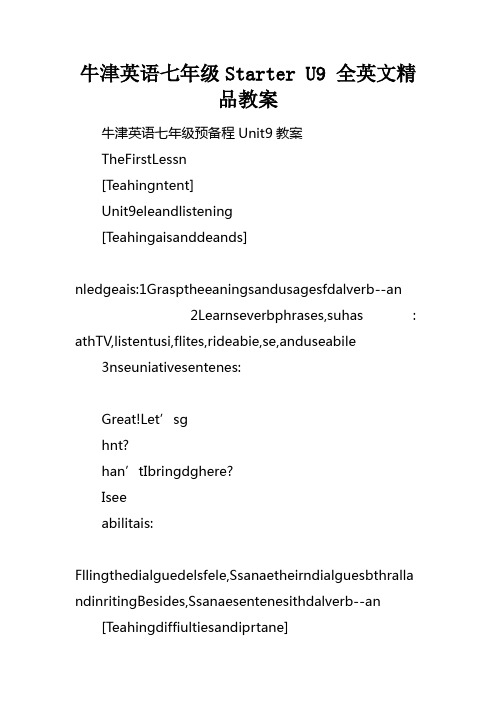
牛津英语七年级Starter U9 全英文精品教案牛津英语七年级预备程Unit9教案TheFirstLessn[Teahingntent]Unit9eleandlistening[Teahingaisanddeands]nledgeais:1Grasptheeaningsandusagesfdalverb--an2Learnseverbphrases,suhas:athTV,listentusi,flites,rideabie,se,anduseabile3nseuniativesentenes:Great!Let’sghnt?han’tIbringdghere?Iseeabilitais:Fllingthedialguedelsfele,Ssanaetheirndialguesbthralla ndinritingBesides,Ssanaesentenesithdalverb--an [Teahingdiffiultiesandiprtane]1Thesenerds:us,h,ride2Thetransfratinfsentenesithdalverb--an,theinterrgativ efr,affirativeandnegativerepl[Teahingtls]PretrandStudents’b,rb[Teahingpredure]Pre-teahingStep1eleandpresentatin1AsSsabutthesignsinpubliplaes,frexaple,Nsing,Nlitteri ng,Nparing,Silene,please,andsetraffisignsnthestreet,fr exaple,Danger,Nstp,Nsund,andsnSthattheteaheranlea dtthesubetfthisunit2AsSstreadthedeldialgue,andplatherle3Afterthat,theteaherassthesequestins:aneplaftballthere?hnt?anthegirlbringherdghere?hnt?4AsSstreadtheverbsandverbphrasesinPartAfListening, andreplaethedeldialgueinelePartiththseusefulverbsrve rbphrases,thus,aetherdialguesusingdalverbsTeahSstheeaningandusagesf“an”,andtheusagesf “pla”asell1)an是情态动词,没有人称和数的转变,后面直接跟动词原形,含义是强调某人做某事的能力,还能够用来表示许可。
英语:Starter Unit9《Signs》教案(2)(译林牛津七年级上)
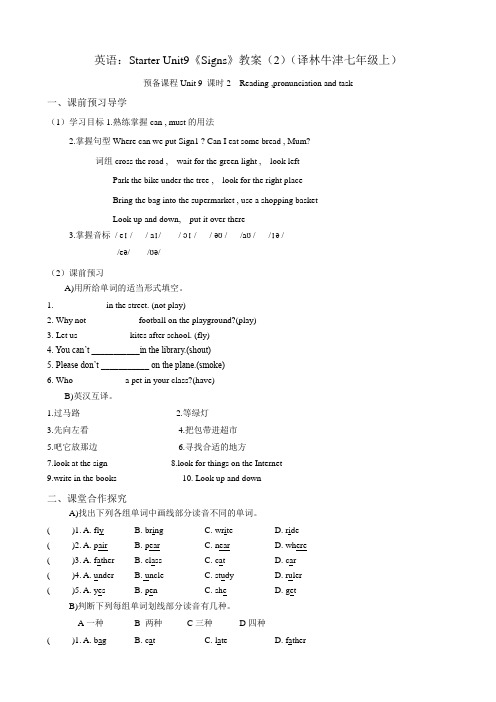
英语:Starter Unit9《Signs》教案(2)(译林牛津七年级上)预备课程Unit 9 课时2 Reading ,pronunciation and task一、课前预习导学(1)学习目标1.熟练掌握can , must的用法2.掌握句型Where can we put Sign1 ? Can I eat some bread , Mum?词组cross the road , wait for the green light , look leftPark the bike under the tree , look for the right placeBring the bag into the supermarket , use a shopping basketLook up and down, put it over there3.掌握音标/ eɪ / / aɪ/ / ɔɪ / / əʊ / /aʊ / /ɪə //eə/ /ʊə/(2)课前预习A)用所给单词的适当形式填空。
1. ___________ in the street. (not play)2. Why not ___________ football on the playground?(play)3. Let us ___________ kites after school. (fly)4. You can’t ___________in the library.(shout)5. Please don’t ___________ on the plane.(smoke)6. Who ___________ a pet in your class?(have)B)英汉互译。
1.过马路________________2.等绿灯________________3.先向左看________________4.把包带进超市________________5.吧它放那边________________6.寻找合适的地方________________7.look at the sign ______________8.look for things on the Internet___________9.write in the books ______________ 10. Look up and down________________二、课堂合作探究A)找出下列各组单词中画线部分读音不同的单词。
人教版英语七年级上册Starter1Unit9全册教学设计
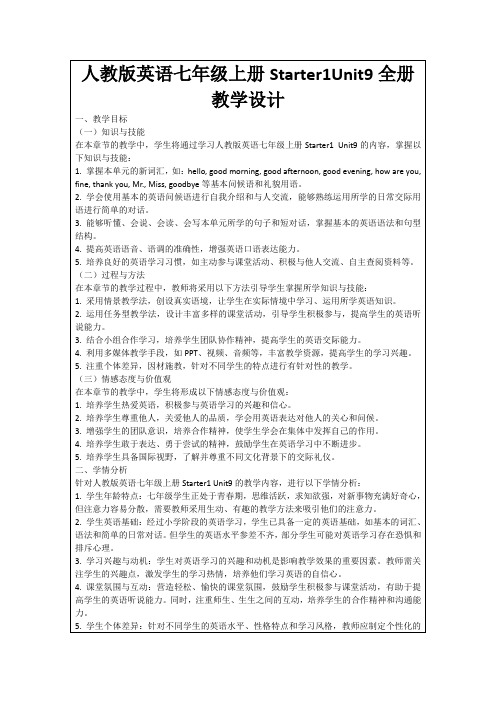
难点:学生往往在语音、语调上存在困难,需要教师耐心纠正和指导,帮助他们提高发音的准确性。
(二)教学设想
1.针对教学重点,设计多样化的听说练习活动,如角色扮演、小组对话、模拟情景等,让学生在模拟真实生活的语境中练习英语对话。
设想:通过这些活动,学生可以在轻松愉快的氛围中学习英语,提高他们的听说能力,同时增强他们对英语学习的兴趣。
(一)教学重难点
1.重点:本章节的重点在于使学生掌握基本的英语问候语和礼貌用语,如hello, good morning, how are you等,并能熟练运用这些词汇和句型进行简单的日常交流。
难点:对于学生来说,正确运用所学的日常交际用语进行实际对话可能存在一定难度,尤其是对于英语基础较弱的学生,需要更多的练习和指导。
四、教学内容与过程
(一)导入新课
在导入环节,教师将采用以下方式激发学生的学习兴趣,为新课的学习做好铺垫:
1.利用PPT展示不同国家的问候图片,让学生观察并猜测图片中的问候语。
-教师与学生互动,引导学生关注图片中的细节,为新课学习营造轻松愉快的氛围。
2.邀请学生上台演示不同国家的问候方式,如握手、拥抱、鞠躬等,让学生在体验中感受文化的多样性。
-教师针对学生的实际问题,提供有针对性的指导,帮助学生克服学习难点。
(四)课堂练习
在课堂练习环节,教师将设计以下活动:
1.设计听力练习,让学生听懂并回应不同场景下的问候语。
-教师关注学生的听力理解能力,提高学生的英语听力水平。
2.设计口语练习,让学生模拟实际生活场景,运用所学知识进行对话。
-教师鼓励学生大胆开口,提高学生的口语表达能力。
牛津英语七年级精品教案(7A-7B全册)
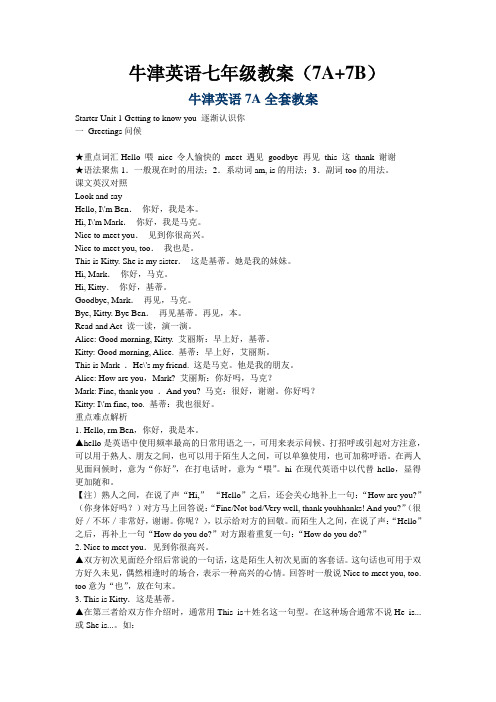
牛津英语七年级教案(7A+7B)牛津英语7A全套教案Starter Unit 1 Getting to know you 逐渐认识你一Greetings问候★重点词汇Hello 喂nice 令人愉快的meet 遇见goodbye 再见this 这thank 谢谢★语法聚焦1.一般现在时的用法;2.系动词am, is的用法;3.副词too的用法。
课文英汉对照Look and sayHello, I\'m Ben.你好,我是本。
Hi, I\'m Mark.你好,我是马克。
Nice to meet you.见到你很高兴。
Nice to meet you, too.我也是。
This is Kitty. She is my sister.这是基蒂。
她是我的妹妹。
Hi, Mark.你好,马克。
Hi, Kitty.你好,基蒂。
Goodbye, Mark.再见,马克。
Bye, Kitty. Bye Ben.再见基蒂。
再见,本。
Read and Act 读一读,演一演。
Alice: Good morning, Kitty. 艾丽斯:早上好,基蒂。
Kitty: Good morning, Alice. 基蒂:早上好,艾丽斯。
This is Mark .He\'s my friend. 这是马克。
他是我的朋友。
Alice: How are you,Mark? 艾丽斯:你好吗,马克?Mark: Fine, thank you .And you? 马克:很好,谢谢。
你好吗?Kitty: I\'m fine, too. 基蒂:我也很好。
重点难点解析1. Hello, rm Ben,你好,我是本。
▲hello是英语中使用频率最高的日常用语之一,可用来表示问候、打招呼或引起对方注意,可以用于熟人、朋友之间,也可以用于陌生人之间,可以单独使用,也可加称呼语。
在两人见面问候时,意为“你好”,在打电话时,意为“喂”。
牛津上海版英语七年级上册Unit9InternationalFoodFestival单元整体教学设计

1.教师邀请几名学生分享本节课的收获和感受,引导他们用英语表达自己的观点。
2.教师对本节课的教学内容进行总结,强调重点词汇、语法和句型,帮助学生巩固所学知识。
3.教师布置课后作业,要求学生运用本节课所学知识,描述家人或朋友的饮食习惯,并在下节课进行分享。
五、作业布置
为了巩固本节课所学知识,培养学生的自主学习能力和跨文化交际意识,特布置以下作业:
2.学生英语水平:经过前几个单元的学习,学生已具备一定的词汇、语法和听说读写能力。但部分学生对一般现在时态的运用尚不熟练,需要在教学过程中加强巩固。
3.学生学习习惯:学生在小组合作、讨论交流等方面表现良好,有利于开展课堂活动。但部分学生自主学习能力较弱,需要在教学中引导和培养。
4.学生情感态度:学生对英语学习抱有热情,但部分学生存在恐惧心理,害怕犯错,导致课堂参与度不高。教师应关注学生的情感需求,创造轻松愉快的学习氛围,鼓励学生大胆开口,自信地使用英语。
1.家庭作业:请学生运用本单元所学的词汇和句型,描述一位家庭成员的饮食习惯,包括喜欢吃的食物、口味等,并尝试用一般现在时态进行表达。要求不少于100词,以提高学生的写作能力。
2.小组作业:各小组选择一个感兴趣的国家,通过网络或书籍查阅相关资料,了解该国的饮食文化、特色美食及餐桌礼仪。小组成员合作完成一份PPT或手抄报,用于下节课进行课堂展示和分享。
设想:采用引导式阅读策略,设置问题链,引导学生深入理解文本内容,并鼓励他们进行批判性思考。
4.写作能力:学生需要能够描述自己喜欢的美食,并表达自己的喜好和理由。
设想:提供写作框架和指导,进行小组讨论和同伴互评,逐步提高学生的写作能力。
(二)教学设想
1.情境导入:通过展示国际美食节的视频或图片,激发学生的学习兴趣,引入单元主题。
牛津译林版初中英语七年级上册全册教案

牛津译林版初中英语七年级上册全册教案
一、教材分析
本教材是牛津译林版初中英语七年级上册全册教材,共包括8个单元,涵盖了日常生活、学校生活、家庭、食物、运动、购物等话题。
每个单元包括了听力、口语、阅读和写作的综合训练。
二、教学目标
1. 培养学生的听、说、读、写的综合能力;
2. 培养学生的研究策略和合作意识;
3. 培养学生对英语研究的兴趣和自信心;
4. 培养学生的跨文化意识和交际能力。
三、教学重点
1. 研究并掌握各单元的语音、词汇、语法和句型;
2. 运用所学知识进行听、说、读、写的综合训练;
3. 发展学生的跨文化意识和交际能力。
四、教学方法
1. 任务型教学法:通过任务设置,激发学生的研究兴趣,培养学生的实际语言运用能力;
2. 合作研究法:鼓励学生与同伴合作,促进他们之间的互动和交流;
3. 情境教学法:通过创设真实的语言环境,让学生在实际情境中运用所学知识。
五、教学内容与步骤
1. 每个单元的教学内容包括听力、口语、阅读和写作等;
2. 根据学生的掌握情况和教学进度,设计相应的教学步骤;
3. 鼓励学生多参与课堂活动,积极表达自己的观点和想法。
六、教学评价
1. 综合评价:通过考试、作业、口语表达、听说能力等多种方式对学生进行全面评价;
2. 自评和互评:鼓励学生进行自我评价和互相评价,提高学生的研究动力和自主研究能力。
七、教学资源准备
1. 教师课件:包括教学课件、题和教学活动设计等;
2. 教学辅助工具:如多媒体设备、录音设备等;
3. 学生教材和练册:提供给学生进行课前预和课后作业。
最新牛津版英语初中七年级上册全册精品教案

最新牛津版英语初中七年级上册全册精品
教案
第一单元:打招呼与自我介绍
教学目标:
- 学会用简单的英语打招呼和自我介绍
- 掌握一些常见的问候语和回答方式
- 能够用英语介绍自己的年龄、姓名、国籍和爱好
教学准备:
- 学生课本和练册
- 教学投影仪
- 音频设备
教学步骤:
1. 引入:播放英语打招呼的视频,让学生感受英语在生活中的应用。
2. 激发学生兴趣:用图片和肢体语言示范常见的问候动作,如握手、拥抱等,并鼓励学生模仿。
3. 研究常见问候语:通过图片和示范,教授英语中常见的问候语,如"Hello","Good morning"等,并让学生跟读。
4. 听力训练:播放相关音频,让学生听力理解和模仿说出各种问候语。
5. 练对话:分成小组进行对话练,让学生用英语进行简单的问候和回答。
6. 自我介绍:示范用英语进行自我介绍,并解释一些常用的句型和词汇。
7. 小组活动:让学生在小组内互相介绍自己的姓名、年龄、国籍和爱好,并鼓励用完整的句子进行表达。
8. 温故知新:通过游戏或练册的相关练,巩固所学内容。
9. 总结:引导学生总结本课所学内容,并鼓励他们在日常生活中多用英语进行问候和介绍。
教学评估:
- 观察学生在对话和小组活动中的表现,评估他们是否能够正确运用所学内容。
- 检查练册上的完成情况,了解学生的掌握程度。
扩展活动:
- 邀请外教或英语达人来校与学生进行互动交流,进一步提高他们的英语口语能力。
- 给学生布置任务,让他们到校园或社区中用英语与陌生人进行简单的交流。
牛津版starter教案
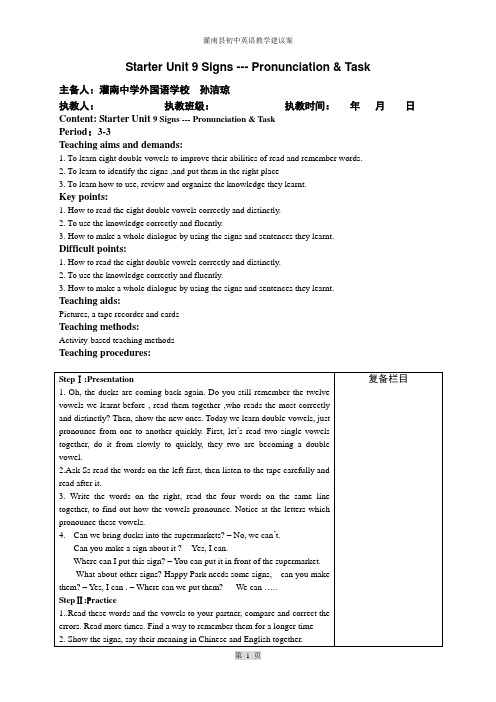
Starter Unit 9 Signs --- Pronunciation & Task主备人:灌南中学外国语学校孙洁琼执教人:执教班级:执教时间:年月日Content: Starter Unit 9 Signs --- Pronunciation & TaskPeriod:3-3Teaching aims and demands:1. To learn eight double vowels to improve their abilities of read and remember words.2. To learn to identify the signs ,and put them in the right place3. To learn how to use, review and organize the knowledge they learnt.Key points:1. How to read the eight double vowels correctly and distinctly.2. To use the knowledge correctly and fluently.3. How to make a whole dialogue by using the signs and sentences they learnt.Difficult points:1. How to read the eight double vowels correctly and distinctly.2. To use the knowledge correctly and fluently.3. How to make a whole dialogue by using the signs and sentences they learnt.Teaching aids:Pictures, a tape recorder and cardsTeaching methods:Activity-based teaching methodsTeaching procedures:随堂达标检测题--- Starter Unit9 (三)(总分30 分,含卷面 2 分)一、用情态动词填空。
牛津英语七年级上册教案
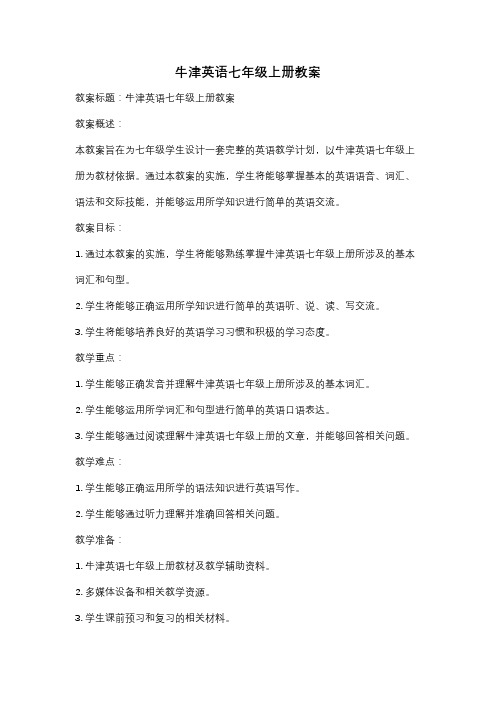
牛津英语七年级上册教案教案标题:牛津英语七年级上册教案教案概述:本教案旨在为七年级学生设计一套完整的英语教学计划,以牛津英语七年级上册为教材依据。
通过本教案的实施,学生将能够掌握基本的英语语音、词汇、语法和交际技能,并能够运用所学知识进行简单的英语交流。
教案目标:1. 通过本教案的实施,学生将能够熟练掌握牛津英语七年级上册所涉及的基本词汇和句型。
2. 学生将能够正确运用所学知识进行简单的英语听、说、读、写交流。
3. 学生将能够培养良好的英语学习习惯和积极的学习态度。
教学重点:1. 学生能够正确发音并理解牛津英语七年级上册所涉及的基本词汇。
2. 学生能够运用所学词汇和句型进行简单的英语口语表达。
3. 学生能够通过阅读理解牛津英语七年级上册的文章,并能够回答相关问题。
教学难点:1. 学生能够正确运用所学的语法知识进行英语写作。
2. 学生能够通过听力理解并准确回答相关问题。
教学准备:1. 牛津英语七年级上册教材及教学辅助资料。
2. 多媒体设备和相关教学资源。
3. 学生课前预习和复习的相关材料。
教学过程:本教案将按照每个单元的教学内容进行安排,以确保学生能够系统地学习和掌握所需的知识和技能。
每个单元的教学过程包括以下几个步骤:Step 1: Warm-up (热身活动)通过一些有趣的活动或问题引发学生对本课主题的兴趣,并复习前面已学过的相关知识。
Step 2: Presentation (知识呈现)通过多媒体设备或其他教学资源,向学生展示本课的新词汇、句型和语法知识,并进行适当的解释和示范。
Step 3: Practice (练习活动)设计一系列的练习活动,包括口语练习、听力练习、阅读练习和写作练习,以帮助学生巩固所学知识和技能。
Step 4: Consolidation (知识巩固)通过小组讨论、角色扮演、游戏等形式,让学生运用所学知识进行实际的交流和互动,以巩固和加深对知识的理解和记忆。
Step 5: Assessment (学习评价)通过一些测试或评估活动,对学生的学习情况进行评价,并及时给予反馈和指导。
2019年新课标牛津初中英语Starter教学建议演示课件-精选.ppt

8 Have /has句型 9 情态动词can,must用法 10一般现在时(陈述句、一般/特殊疑问句) 11 动词变化:-s,-es,-ies 12 特殊疑问句
When/How/Who/Where/What …?
精选
关注点
单词必须过关,养成读背单词的习惯。 音标必须过关,为单词打下坚实的基础。 基本语法必须过关,为阅读理解做好准备。 课堂用语必须过关,让学生学会用英语沟通。 课文背诵必须过关,帮助学生加深对文章的理解,
Before teaching
1. Set a clear, specific purpose
for each lesson;
2. Learning by doing;
3. Genuine VS authentic
(真的)
(真实性的)
精选
贝塔朗菲系统论的主要原则 “整体大于部分之和”
话题统领整个单元 功能贯穿整个单元 结构遍布整个单元 任务串起整个单元
1. 能在口头表达中做到发音清楚、语调达意; 2. 能就所熟悉的个人和家庭情况进行简短对话; 3. 能运用一些最常用的日常套语(如问候、告别、
致谢、致歉等); 4. 能在教师的帮助下讲述简单的小故事。
精选
《课程标准》二级语音知识目标:
1. 知道错误的发音会影响交际; 2. 知道字母名称的读音; 3. 了解简单的拼读规律; 4. 了解单词有重音; 5. 语音清楚,语调自然。
新课标牛津初中英语
Starter教学建议
徐州市中小学教学研究室 田 莉
精选
内容
衔接教学的目的、策略 教学建议
目的:通过调整衔接教材 解决衔接问题
精选
孩子们在进入初中前就有了不一样的英语基础 教学观念(主要体现在教学目的上) 教学方法 教学要求 重视衔接准备(教师,学生和家长)
(七年级英语教案)StarterU9U10教材分析更完美了
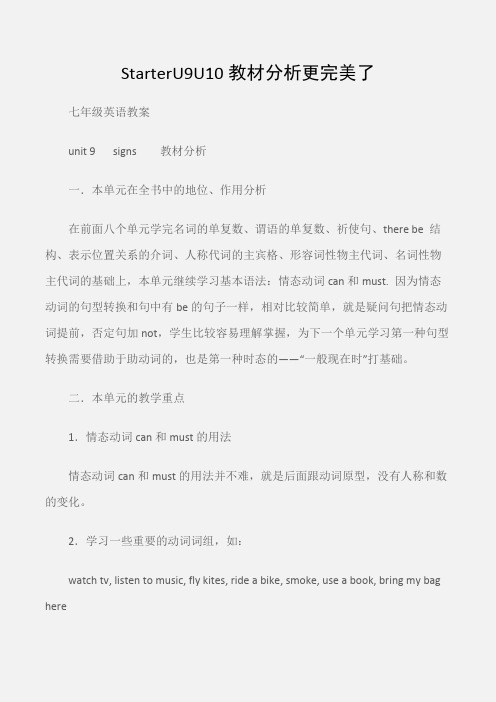
StarterU9U10教材分析更完美了七年级英语教案unit 9 signs 教材分析一.本单元在全书中的地位、作用分析在前面八个单元学完名词的单复数、谓语的单复数、祈使句、there be 结构、表示位置关系的介词、人称代词的主宾格、形容词性物主代词、名词性物主代词的基础上,本单元继续学习基本语法:情态动词can和must. 因为情态动词的句型转换和句中有be的句子一样,相对比较简单,就是疑问句把情态动词提前,否定句加not,学生比较容易理解掌握,为下一个单元学习第一种句型转换需要借助于助动词的,也是第一种时态的——“一般现在时”打基础。
二.本单元的教学重点1.情态动词can和must的用法情态动词can和must的用法并不难,就是后面跟动词原型,没有人称和数的变化。
2.学习一些重要的动词词组,如:watch tv, listen to music, fly kites, ride a bike, smoke, use a book, bring my bag here3.学习几个重要的交际用语:great! let’s go. why not? why can’t i bring my dog here? 和i see.4.学习一些有关交通规则的常识,并尽量用英语表述。
三.本单元的教学难点1.要向学生讲明,can的含义不止一种,用法都是后面跟动词原型,没有人称和数的变化:1)表示请求和许可,例如:can i bring my bag here?you can’t play footb all here.2)表示某人做事的能力,例如:i can swim.2. must的否定回答特别不容易掌握。
如果用must提问,肯定回答说yes, you must. 否定回答要说no, you needn’t.不能用must的否定形式mustn’t, 因为mustn’t表示“不许”,含义接近于can’t3.在speaking部分,会碰到这个语法:否定句中并列成分之间用or连接,如果后一句也有not,那么才用and连接。
牛津上海版初一七年级上英语 unit9 同步复习教案
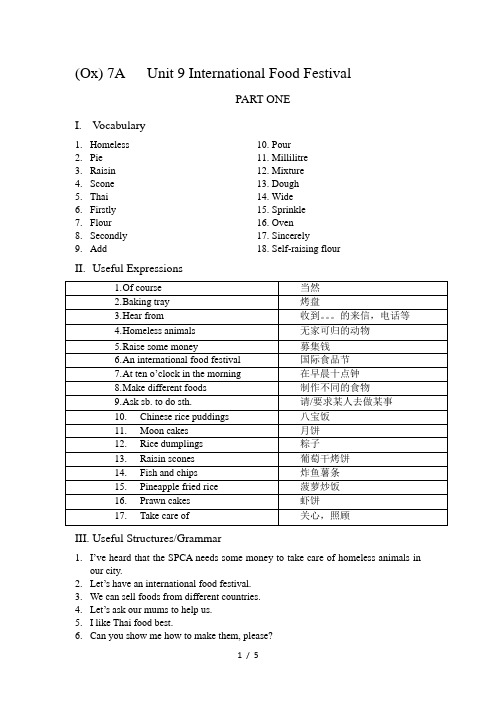
(Ox) 7A Unit 9 International Food FestivalPART ONEI.V ocabulary1.Homeless2.Pie3.Raisin4.Scone5.Thai6.Firstly7.Flour8.Secondly9.Add 10.Pourlilitre12.Mixture13.Dough14.Wide15.Sprinkle16.Oven17.Sincerely18.Self-raising floureful Expressionseful Structures/Grammar1.I’ve heard that the SPCA needs some money to take care of homeless animals inour city.2.Let’s have an international food festival.3.We can sell foods from different countries.4.Let’s ask our mums to help us.5.I like Thai food best.6.Can you show me how to make them, please?Of course.7.May I have two raisin scones and a plate of fish and chips, please?Of course.PART TWOI.Word Formation1.home(adj.)________2.first(adv.) ________3.mix(n.) ________4.wide(adv.) ________5.sincere(adv.) ________6.crowd(adj.) ________7.nation(adj.) ________8.luck(adj.) ________ 9.play(n.) ________e(adj.) ________11.luck(adj.) ________12.warn(n.) ________13.success(adj.) ________14.success(v.) ________15.success(adv.) ________plete the sentence with the given word in the correct form.1.A: Can you tell me how to use the computer?B. Sorry, I am not good at it________.(I)2. Every year we take many ________in Shanghai . ( photo )3. Many tourists usually go to the Bund for sightseeing and ________. ( funny )4. Mary, a friend of mine lives on the ________floor of a new highrise in Shanghai.(twenty)5. Don’t miss a new cartoon. It is very________ (excite )6. Dogs can help blind people walk across the street________ (safe)7.If you go to the Forbidden City, you will see many ancient________. (build)8. After hearing the old woman’s words, Linda’s face turned still________ ( red )9.After the tornado, many people became ________ and had to rebuild their houses. (home)10.She doesn’t like the ________potatoes at all.(bakery)III.Sentence Transformation1.I am going to sell Chinese food.(对划线部分提问)________ ________ of food are you going to tell?2.I’d like to buy some food for dinner.(改为一般疑问句)________ you ________ to buy some food for dinner?3.The hot dogs cost $9.8. (对划线部分提问)________ ________ do the hot dogs cost?4.I’m going to sell food from India. (同义句转换)I am going to sell ________ ________.5.You will need some self-raising flour to make scones.( 同义句转换)________ ________ scones you will need some self-raising flour.6.The tourists had a good time in Shanghai. (改为一般疑问句)________the tourist________ a good time in Shanghai?IV.Multiple Choice1. Guide dogs help ______ blind walk free in the street.A) a B) an C) the D) /2. A healthy diet is essential ______ everybody. You should care more about what you eat.A) for B) to C) in D) about3. A friend of mine usually sells some vegetables and shares ______ with his family.A) another B) other C) the rest D) the other4. My mother is a creative cook, so she often cooks ______ for me every weekend.A) anything different B ) nothing differentC) something different D) everything different5. As people get older, their short-term memory becomes ______ and they can'tremember things clearly.A) bad B) worse C) better D)good6. When an earthquake happens, you should go outside as ______ as possible.A) quick B) quicker C) more quickly D) quickly7. Jenny often thinks of herself, ______ her sister, Mary is very friendly to others.A) so B) but C) and D) or8. The old man still coughed a lot ______ he took some medicine.A) if B) since C) because D) although9. The summer holiday is coming, so he decides ______ to Beijing for his holidays.A) go B) to going C) going D) to go10. The thief denied ______ the mobile phone from the young lady when he was caught.A) stealing B) to steal C) steal D) stole11. I ______ from Mr. Black since he moved to Beijing. I'll visit him when I go there.A) haven't heard B) won't hearC) don't hear D) didn't hear12. My sister ______ much charity work in her free time when she entered college.A) has done B) will do C) did D) does13. After the serious illness Ebola (埃博拉疫情) happens, more doctors ______ tohelp save the patients in Africa.A) needed B) are needed C) need D) are needing14. Before taking a plane at the airport, all passengers ______ go through safety check.A) can B) must C) may D) ought to15. ______ warm and rainy weather it was last November in Shanghai!A) What B) What a C) What an D) How16.Who can teach me ________ to make a chocolate cake?A.whatB. howC. whenD. where17.le t’s ________ some sugar on the strawberries.A) sprinkle B) to sprinkle C) sprinkling D) sprinkled18.--________ will your plane leave?--At 11.40 a.m.A. How oftenB. WhereC. What timeD. How19.- I think teenagers should be strict with themselves at any time.- ______A) I agree. B) Not at allC) That's all right. D) That's a good idea.20. - Excuse me, I want to complain about this soya milk.- ______A) How do you like it? B) Do you agree?C) What's the problem? D) What do you think?1-5 C A C C B 6-10D B DDA 11-15ACBBA 16-20BACACV.Reading comprehensionSection A.Section BVI.Read the passage and fill in the blanks with proper wordsVII.Translation1.在别人眼里,汤姆没希望了。
Unit 9教案2021-2022学年牛津上海版英语七年级下册
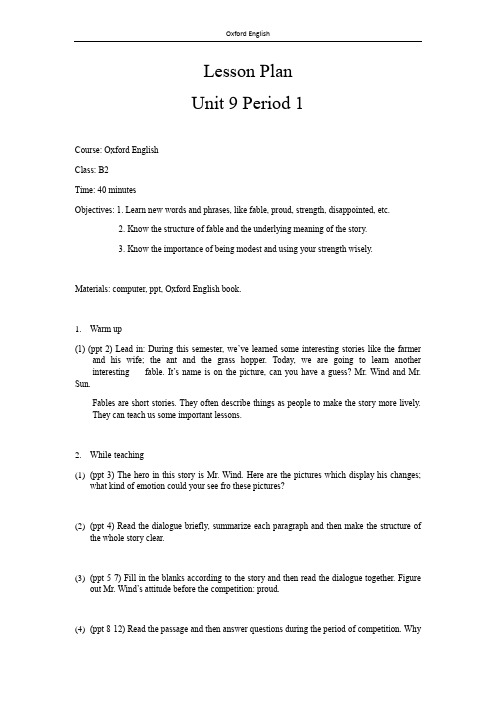
Lesson PlanUnit 9 Period 1Course: Oxford EnglishClass: B2Time: 40 minutesObjectives: 1. Learn new words and phrases, like fable, proud, strength, disappointed, etc.2. Know the structure of fable and the underlying meaning of the story.3. Know the importance of being modest and using your strength wisely. Materials: computer, ppt, Oxford English book.1.Warm up(1) (ppt 2) Lead in: During this semester, we’ve learned some interesting stories like the farmerand his wife; the ant and the grass hopper. Today, we are going to learn another interesting fable. It’s name is on the picture, can you have a guess? Mr. Wind and Mr. Sun.Fables are short stories. They often describe things as people to make the story more lively.They can teach us some important lessons.2.While-teaching(1)(ppt 3) The hero in this story is Mr. Wind. Here are the pictures which display his changes;what kind of emotion could your see fro these pictures?(2)(ppt 4) Read the dialogue briefly, summarize each paragraph and then make the structure ofthe whole story clear.(3)(ppt 5-7) Fill in the blanks according to the story and then read the dialogue together. Figureout Mr. Wind’s attitude before the competition: proud.(4)(ppt 8-12) Read the passage and then answer questions during the period of competition. Whyhe got angry, tired and disappointed? Compare the different things they do in a table. After Mr.Sun won, Mr. Wind was very sad.(5)(ppt 13-14) After the competition, Mr. Wind learned a lot from Mr. Sun and became happy.Answer 5 questions according to the ending parts.(6)(ppt 15) With the help of key words and pictures, try to retell the key parts of the fable.3.Post-teaching(1) (ppt 16-17) Summarize what we can learn from this story? Eg: Strength is not the mostimportant thing.(2) Homework:a.Recite all the new words and text. Copy new words.b. Continue the story: What will Mr Wind do after the competition.Lesson PlanUnit 9 Period 2Course: Oxford EnglishClass: B2Time: 40 minutesObjectives: 1. Learn new words and phrases, like reel, stick, string, etc.2. Learn steps of making a kite.Materials: computer, ppt, Oxford English book.1.Warm up(1)Do dictation (new words and sentences learned in the previous lesson).(2)(ppt 2) In autumn, we can do many outdoor activities. And one of them needs the help of Mr.Wind. Can you guess what is it? Flying a kites. So today we are going to learn how to make a kite ourselves. First, we need to get all the things we need for making a kite.2.While-teaching(1) (ppt 3-4) Read the steps of making kites and link them with correct pictures. Add correct adverbs at the beginning of each step.(2)(ppt 5-7) Listen and repeat the 4 steps. Then try to retell the steps with key words and pictures.3.Post-teaching(1) (ppt 8) Write down the steps for making your own kite. Add more details to make it morespecial.(2) Homework:a. Recite all the new words and key sentences (including the ones in Notes).b. Copy new words.c. Draw a kite for yourself.Lesson PlanUnit 9 Period 3Course: Oxford EnglishClass: B2Time: 40 minutesObjectives: 1. Learn the correct usage of new words, like: as... as, ... than ..., etc.2. Review comparative and superlative forms and self pronoun.3. Learn different ways to compare 2 or more things.Materials: computer, ppt, Oxford English book.1. Warm up(1) Do dictation.(2)(ppt 2) After making their kites, children display their kite to each other. Let’s read andrepeat the dialogue together.2. While-teaching(1) (ppt 3-6) Take out students own kites, compare their pictures with comparatives. Compare thekites in your group. You can use the following sentence patterns to help you. …(not) as(so) …as;…as…as…; …than …; …the ~ of all the three(2) (ppt 11) Review the spelling of some adjectives.(3) (ppt 8-10) Choose the correct superlatives/ comparatives and self pronouns according to thecontext.3. Post-teaching(1) (ppt 11-13) Read the article about shopping. Then fill in the blanks. Add more with your ownattitudes on shopping.(2) Homework:a. Recite all the new words and text. Copy new words.b. Write 5 sentences with comparatives, superlatives and self pronouns.Lesson PlanUnit 9 Period 4Course: Oxford EnglishClass: B2Time: 40 minutesObjectives: 1. Learn the correct usage of new words, like: rise, dive, flap, etc.2.Try to appreciate poems about wind and sun.3. Try to write a short poem about other natural elements.Materials: computer, ppt, Oxford English book.1. Warm up(1) Do dictation.(2)(ppt 2-3) Listen and read the poem together.2. While-teaching(1) (ppt 4-5) Answer questions according to the poem.(2) (ppt 6) Brain storm: What do you see when the wind blows?(3) (ppt 7-10) Kitty, Alice and Peter are writing a poem about the wind. Read their poem together.3. Post-teaching(1) (ppt 11-12) With the help of the first letter, complete the poem of the Sun.(2) (ppt 13) In groups, think about what happens when the Sun shines/the snow falls/the typhooncomes/the rain falls.(3) Homework:a. Recite all the new words and text. Copy new words.b. Write your own poems with one of the natural elements.。
牛津上海版七年级下册U9教案
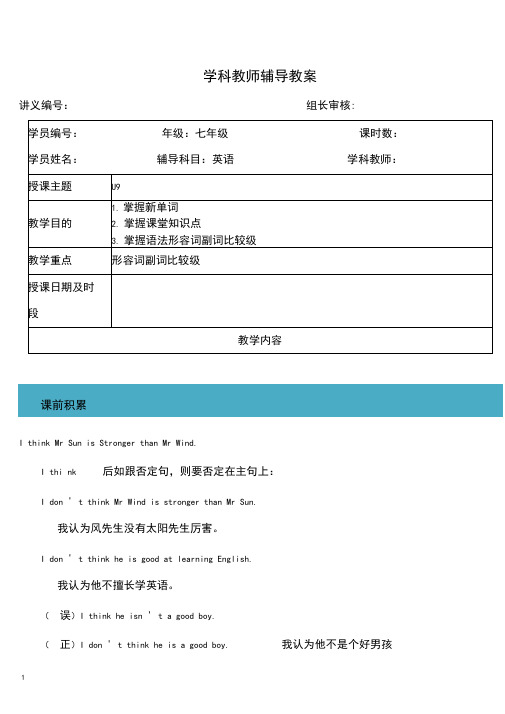
学科教师辅导教案讲义编号:组长审核:I think Mr Sun is Stronger than Mr Wind.I thi nk 后如跟否定句,则要否定在主句上:I don ' t think Mr Wind is stronger than Mr Sun.我认为风先生没有太阳先生厉害。
I don ' t think he is good at learning English.我认为他不擅长学英语。
(误)I think he isn ' t a good boy.(正)I don ' t think he is a good boy. 我认为他不是个好男孩、.课文讲解:P59--P641、read the story about the ComPetiti On betwee n Mr. Wind and Mr. Sun 读风先生和太阳先生之间竞赛的故事have a COmPetitiOn 进行比赛/竞赛COmPete (v.) 竞争、参赛COmPetitOr (n.) 参赛者COmPetition (n.) 竞赛2、between…and …在.......... 禾和……•之间3、blow down 吹倒4、PUt the ParagraPhS in the COrreCt order 将段落按正确顺序排放5、find out (通过杳询)搞清楚,弄明白look for寻找(表示找的过程)find发现,找到(表示找的结果)6、do Sth to show his Stre ngth 做某事来显示他的力量7、become /be frie nds 成为朋友8 Iearn Sth from the story 从这个故事学到一些东西9、like showi ng off his Stre ngth 喜欢炫耀他的力量10、all the time = always 一直,总是11、be (not) as Str ong as each other 互相一样强壮12、get his coat off 脱去他的衣服13、in the ShOrteSt time 在最短的时间里14、blow and blow 吹呀吹Wait and Wait 等呀等15、become red / Very angry 变红了/ 变得很生气了angry adj. 生气的be angryWith生某人的气16、begi n to blow hard 开始使劲吹(开始做) Start SWeati ng 开始出汗(已发生)large - Iarger - largest; nice - nicer - nicerst⑶ 原形容词词尾是辅音字母+ y时,去y,加ier, iest 构成比较级和最高级:dry —drier —driest; frie ndly —frien dlier —frien dliestPretty —Prettier —prettiest; easy —easier —easiest;⑷ 原形容词是重读闭音节时,双写词末辅音字母,加er, est 构成比较级和最高级:big —bigger —biggest; hot —hotter —hottest;thi n —thinner —thinn est; Wet —Wetter --wettest(5)部分双音节及三个音节以上的形容词,在其前加more, most构成比较级和最高级:beautiful —more beautiful -- most beautiful;comfortable - more comfortable -- most comfortable;difficult -- more difficult -- most difficult;expe nsive -- more expe nsive -- most expe nsive(6)不规则的变化须记住:bad - worse - worst; good / well - better - best;many / much - more - most(注意:原形容词最高级前须加定冠词the )句型如下:A.同级相比(肯定)as …as ;(否定)not as(so) …asB.比较级:形容词比较级+ than …C.最高级:形容词最高级+ in 群体1.我的风筝没有你的大。
- 1、下载文档前请自行甄别文档内容的完整性,平台不提供额外的编辑、内容补充、找答案等附加服务。
- 2、"仅部分预览"的文档,不可在线预览部分如存在完整性等问题,可反馈申请退款(可完整预览的文档不适用该条件!)。
- 3、如文档侵犯您的权益,请联系客服反馈,我们会尽快为您处理(人工客服工作时间:9:00-18:30)。
the first lesson
2. ask ss to read the model dialogue, and play the role.
3) play的意思是"玩,打,演奏",当它后面是球类词时,中间不加任何冠词,如:play football, play basketball, play table tennis, play volleyball.
而当play后面跟乐器时,则在他们中间加定冠词the, 如:play the piano, play the violin, play the guitar.
step 2 listening
unit 9 speaking and reading
2. learn the meaning and usage of modal verb “must”
ability aims:
step 1. speaking
step 2 reading
step 3
1) must是情态动词,没有人称和数的变化,后面直接跟动词原形和be 动词的原形,其意义为"必须",它的否定句是在must 后面直接加not, 缩写形式为mustn't, 意思是"禁止,不允许",
2) must的一般问疑问,就是把must提前。
但是,must的否定回答特别不容易掌握。
如果用must提问,肯定回答说yes, you must. 否定回答要说no, you needn’t.
前者指集中注意力,有意地用眼睛"看",强调看的动作。
(它后面跟宾语时要加at)。
如:
she looks at herself in the glass. look for 表示"寻找"的过程和动作。
